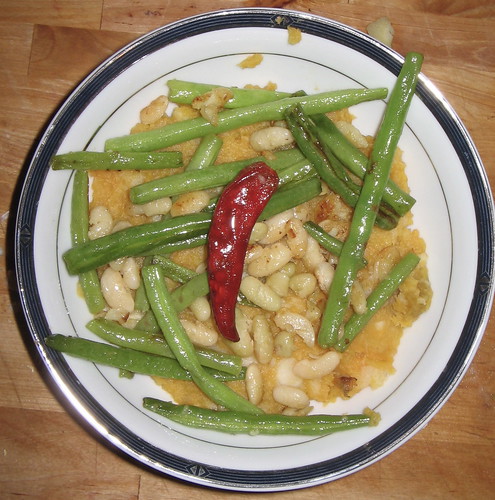Worship and Dinner
The Wife and I just held our first real dinner party in this house. It was a potluck for our Quaker Meeting (equivalent to our church), to welcome a new member into the community. In general, it went really well--assuming your definition of really well is open to encompassing a kid throwing a fit because he was in an unusual environment, a mom who has been sick as a dog for a week, extra guests and extra food sensitivities.
Part of what is important about food is how it makes community. I think this is particularly true in religious communities. I was raised Catholic; there, it was about the sanctified food of the Body and Blood of Christ. Among Quakers, it's social hour, that period after Meeting for Worship when we drink coffee, eat saltines with peanut butter, and talk. By committing this act of eating together, so closely tied together with the experience of the divine, no matter what we name it, we draw ourselves closer to some center we stand around, until we touch each other, gently, at the edges.
But the dynamics of this are complicated by the dynamics of what we can eat. The Body and Blood are made of wheat and alcohol; and do crackers and peanut butter set any better precident? I've taken it upon myself to bring things to Meeting whenever we have a 'big eating event,' such as a potluck, or the afternoons before Business Meeting when folks eat lunch to prepare for the three hours of worship-slash-collective-self-government that is about to happen. My dishes always come neatly labelled "VEGAN/NO DAIRY, EGGS, OR MEAT/FISH/SHELLFISH, GLUTEN/WHEAT FREE, NO CORN OR SOY, ASK IN KITCHEN FOR DETAILS" so that people know, at least, what they are getting into. I want to extend that community created through eating to everyone around me.
Which is part of why tonight was complicated. Among the 10 people at the table, one has celiac disease and is gluten free, one follows a gluten-free/casein-free/soy-free diet, one is a vegetarian, one is on a 3 week detox diet that involves, inter alia, no gluten, no animal products, and no refined sugar, and one has multiple, but mild, food sensitivities and avoids gluten, soy, corn, dairy, kidney beans, and I think some other things I didn't catch. 2 of those people didn't announce their sensitivities in advance, which made things a little awkward: I would have kept the crackers separate if I'd known that there was an dairy allergy (as opposed to avoidance) in the bunch, for instance, and probably wouldn't have put the cheese at little-kid-height. But I had my brain on sensitivities, knew what was in everything I put out, and even pulled the cake mix bag out of the recycling so everyone could read the ingredients.
As we sat down to eat, we held hands to say a silent Quaker grace. In that moment, I felt the connection. Each of the ten people in my house to each was a tangible spiritual being, and for that moment, we bumped into each other and stayed there. The woman we were welcoming squeezed my hand, and I opened my eyes. We all looked around the table, and there was a moment when we exhaled, together. Then we smiled down at our bowls of soup and began to eat.
Hors d'oeuvres:
Cheese plate: fresh chevre, New York cheddar, and raclette
Crackers: Almond Nut Thins (contains nuts, dairy), Tamari Sesame Rice Crackers (contains soy, sesame seeds), corn crispbreads (contains corn, rice)
Kalamata and Picholine Olives
Mixed nuts (pecans, roasted cashews, and raw almonds)
Vegan Terrine (purchased, though I had wanted to make one)
Drinks:
Unfiltered apple juice
Orange juice
Filtered water
2005 Côtes du Rhone (red--is there another type?) (brought by Ted)
First Course
Potato-Leek Soup (by Ted and Nina)
Main Course
Romaine Salad with carrots, cucumbers, grape tomatoes, and string beans (by Mary and Helen)
Polenta, served with Good Mother Stollard Beans cooked in sage and garlic (by me and The Wife)
Green beans cooked with shallots and garlic (by Shannon and Giancarlo)
Dessert
Namaste Spice Cake
Apple Millet
Beans with sage: Boil as many Good Mother Stollard beans as possible. Cranberry, Borlotti, or Pinto beans would be a good substitute. When boiled, drain, and put a good amount of olive oil or butter in the pan. If using butter, let it brown slightly. Add the beans, along with tons of chopped fresh sage and 2-3 cloves of garlic. Cook until the outside skins of the beans become crispy and crunchy, and they have started to stick to the pan. Serve over polenta.
Apple Millet: Chop 1/4 cup dried apples. Rehydrate in warm water, about a cup but there's no need to measure. (This step can be done up to a few days in advance and then stored in the fridge, or can sit on the counter for a few hours while you do other things.) Drain the apples, pour the liquid into a measuring cup, and top off with enough apple juice (unfiltered, unsweetened, please) to make 2 cups. Put 1 cup millet, the rehydrated apples, the apple juice/soaking liquid, and about 1/2 cup more water into a pot with a sprinkling of cinnamon. Simmer until the millet is done, about 20 minutes to half an hour. Does not need to be served immediately.
Part of what is important about food is how it makes community. I think this is particularly true in religious communities. I was raised Catholic; there, it was about the sanctified food of the Body and Blood of Christ. Among Quakers, it's social hour, that period after Meeting for Worship when we drink coffee, eat saltines with peanut butter, and talk. By committing this act of eating together, so closely tied together with the experience of the divine, no matter what we name it, we draw ourselves closer to some center we stand around, until we touch each other, gently, at the edges.
But the dynamics of this are complicated by the dynamics of what we can eat. The Body and Blood are made of wheat and alcohol; and do crackers and peanut butter set any better precident? I've taken it upon myself to bring things to Meeting whenever we have a 'big eating event,' such as a potluck, or the afternoons before Business Meeting when folks eat lunch to prepare for the three hours of worship-slash-collective-self-government that is about to happen. My dishes always come neatly labelled "VEGAN/NO DAIRY, EGGS, OR MEAT/FISH/SHELLFISH, GLUTEN/WHEAT FREE, NO CORN OR SOY, ASK IN KITCHEN FOR DETAILS" so that people know, at least, what they are getting into. I want to extend that community created through eating to everyone around me.
Which is part of why tonight was complicated. Among the 10 people at the table, one has celiac disease and is gluten free, one follows a gluten-free/casein-free/soy-free diet, one is a vegetarian, one is on a 3 week detox diet that involves, inter alia, no gluten, no animal products, and no refined sugar, and one has multiple, but mild, food sensitivities and avoids gluten, soy, corn, dairy, kidney beans, and I think some other things I didn't catch. 2 of those people didn't announce their sensitivities in advance, which made things a little awkward: I would have kept the crackers separate if I'd known that there was an dairy allergy (as opposed to avoidance) in the bunch, for instance, and probably wouldn't have put the cheese at little-kid-height. But I had my brain on sensitivities, knew what was in everything I put out, and even pulled the cake mix bag out of the recycling so everyone could read the ingredients.
As we sat down to eat, we held hands to say a silent Quaker grace. In that moment, I felt the connection. Each of the ten people in my house to each was a tangible spiritual being, and for that moment, we bumped into each other and stayed there. The woman we were welcoming squeezed my hand, and I opened my eyes. We all looked around the table, and there was a moment when we exhaled, together. Then we smiled down at our bowls of soup and began to eat.
Menu for Spiritual Enlightenment
In Honor of Nichole
In Honor of Nichole
Hors d'oeuvres:
Cheese plate: fresh chevre, New York cheddar, and raclette
Crackers: Almond Nut Thins (contains nuts, dairy), Tamari Sesame Rice Crackers (contains soy, sesame seeds), corn crispbreads (contains corn, rice)
Kalamata and Picholine Olives
Mixed nuts (pecans, roasted cashews, and raw almonds)
Vegan Terrine (purchased, though I had wanted to make one)
Drinks:
Unfiltered apple juice
Orange juice
Filtered water
2005 Côtes du Rhone (red--is there another type?) (brought by Ted)
First Course
Potato-Leek Soup (by Ted and Nina)
Main Course
Romaine Salad with carrots, cucumbers, grape tomatoes, and string beans (by Mary and Helen)
Polenta, served with Good Mother Stollard Beans cooked in sage and garlic (by me and The Wife)
Green beans cooked with shallots and garlic (by Shannon and Giancarlo)
Dessert
Namaste Spice Cake
Apple Millet
Recipes:
Polenta: I made crock-pot polenta, since I didn't want to have to jump up and cook during dinner. 6 cups water, 2 cups stone-ground cornmeal, teaspoon of salt, on high for 3 hours, on low for 2.Beans with sage: Boil as many Good Mother Stollard beans as possible. Cranberry, Borlotti, or Pinto beans would be a good substitute. When boiled, drain, and put a good amount of olive oil or butter in the pan. If using butter, let it brown slightly. Add the beans, along with tons of chopped fresh sage and 2-3 cloves of garlic. Cook until the outside skins of the beans become crispy and crunchy, and they have started to stick to the pan. Serve over polenta.
Apple Millet: Chop 1/4 cup dried apples. Rehydrate in warm water, about a cup but there's no need to measure. (This step can be done up to a few days in advance and then stored in the fridge, or can sit on the counter for a few hours while you do other things.) Drain the apples, pour the liquid into a measuring cup, and top off with enough apple juice (unfiltered, unsweetened, please) to make 2 cups. Put 1 cup millet, the rehydrated apples, the apple juice/soaking liquid, and about 1/2 cup more water into a pot with a sprinkling of cinnamon. Simmer until the millet is done, about 20 minutes to half an hour. Does not need to be served immediately.







